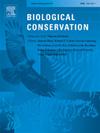树木和林分特征共同预测生产林保留树上与树木相关的微生境
IF 4.9
1区 环境科学与生态学
Q1 BIODIVERSITY CONSERVATION
引用次数: 0
摘要
30 年前,保留林作为一种改善砍伐对生物多样性影响的手段出现,并已成为许多国家森林管理的一个组成部分。如今,人们仍然越来越需要评估保留林在多大程度上促进了生产林的生物多样性。我们利用与树木相关的微生境(TreMs)作为森林承载生物分类多样性潜力的指标,以更好地了解阔叶保留树以及林分管理所产生的周边条件对生物多样性的影响。我们调查了瑞典南部 20 个以针叶树为主的偶数年生生产林(欧洲冷杉)中四种阔叶树类(桦树属、法桐属、柞树属和山杨属)的 114 棵保留树的 TreM 类型。我们评估了保留树属性(树种和树龄)和周围环境(生产树密度和与保留树的距离)对 TreM 类型和组群多样性的影响。我们发现,具有不同特征和生理生态位的保留树种(需光树种与耐荫树种、先锋树种与晚成树种)会形成不同的树木多样性。随着保留树树龄和周围树木密度的增加,树胶多样性也明显增加。较高的周围树木密度尤其与某些树木形态有正相关(树冠枯死木、红叶植物)或负相关(根部凹陷、地衣)。总体而言,留存林对森林生物多样性的潜在贡献程度将取决于推广不同的阔叶留存树种,并对周围树木进行相应管理,使留存树变老并长期保持树木形态。本文章由计算机程序翻译,如有差异,请以英文原文为准。
Tree and stand characteristics jointly predict tree-related microhabitats on retention trees in production forests
Retention forestry emerged as a means of ameliorating the biodiversity impacts of clearcutting 30 years ago and has become an integrated part of forest management in many countries. Nowadays, there is still an increasing need to assess to what extent retention trees contribute to biodiversity in production forests. We used tree-related microhabitats (TreMs), as an indicator of the potential of the forest to host taxonomic biodiversity, to better understand the effect of broadleaf retention trees, and surrounding conditions derived from stand management, on biodiversity. We inventoried TreM types on 114 retention trees of four broadleaf tree taxa (Betula spp., Fagus sylvatica, Quercus spp., and Populus tremula) located within 20 even-aged conifer-dominated production forests (Picea abies) in southern Sweden. We evaluated the effect of retention tree attributes (species and age) and of the surrounding environment (production tree density and distance to the retained trees) on the diversity of TreM types and groups. We found that retention tree species with different characteristics and physiological niche (light-demanding vs. shade-tolerant and pioneer vs. late-successional) developed distinct TreM assemblages. TreM diversity increased significantly with increasing retention tree age and surrounding tree density. Higher surrounding tree density is particularly related to some TreMs either positively (crown deadwood, bryophytes) or negatively (buttress-root concavities, lichens). Overall, the extent that retention forestry potentially contributes to forest biodiversity will depend on promoting different broadleaved retention tree species and managing surrounding trees accordingly to allow retention trees to become older and maintain TreMs in the long term.
求助全文
通过发布文献求助,成功后即可免费获取论文全文。
去求助
来源期刊

Biological Conservation
环境科学-环境科学
CiteScore
10.20
自引率
3.40%
发文量
295
审稿时长
61 days
期刊介绍:
Biological Conservation is an international leading journal in the discipline of conservation biology. The journal publishes articles spanning a diverse range of fields that contribute to the biological, sociological, and economic dimensions of conservation and natural resource management. The primary aim of Biological Conservation is the publication of high-quality papers that advance the science and practice of conservation, or which demonstrate the application of conservation principles for natural resource management and policy. Therefore it will be of interest to a broad international readership.
 求助内容:
求助内容: 应助结果提醒方式:
应助结果提醒方式:


